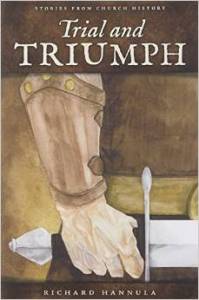Using biographies to expand writing skills has the added benefit of learning history. Richard M. Hannula’s Trial and Triumph provides us with valuable mini-biographies of men and women throughout church history. Once the writing student can write five-sentence paragraphs, we can introduce him to the extended paragraph following the same outline as the five-sentence paragraph. This time we add two more sentences to each of the three points expressed in the body sentences.
- Introduction sentence 1 or more
- Body sentence 3 sentences
- Body sentence 3 sentences
- Body sentence 3 sentences
- Conclusion sentence 1 or more
Peter Waldo and the Waldensians –Faithful to the Word – c. 1130 – 1217
In about 1170, wealthy men, government and church leaders met in the home of Peter Waldo in Lyons, France. While enjoying their own company one of them fell dead for no apparent reason. Stunned, Waldo thought that it could have been himself lying dead on the floor. He began to thinking about his own life and listening to a few Latin Bible references a week did not satisfy him anymore. Peter hired two men to translate the Gospels and other parts of the Bible into French. Believing the verse saying to sell all and follow Christ, Waldo and his friends sold everything and gave to the poor. Some called these people Waldensians and other called them “the poor men of Lyons.” While he and others who trusted Christ and began preaching the Gospel intended to help the church, the leaders of the church, including the Pope, forbade them to preach and use the Bible in common languages. Their response: “We must obey God rather than men.” Thus, they were forced to leave France and went to Italy. From there, in the dead of winter, the church leader gave them a choice to leave or return to the teachings of the Roman Church. One pastor said that every one of the two thousand people in his church chose to leave. In the trail, they left stains of blood because of the difficulty of the trip. In the spring, armies found and martyred many of these believers. Even so, those who survived remained faithful to the Word. (Reviewer’s comment: Others believe the Waldensians preceded Peter Waldo by as many as 1100 years.)
John Wyclif – The Morning Star of the Reformation – c. 1330-1384
John Wyclif went to Oxford University for fame and prestige in the academic world, but while there God saved him and gave him a desire to study, live and preach God’s Word. Years later, he did become a leading professor at Oxford, however, when he began preaching from the English Bible, the leaders of the Church of Rome sought to stop him. Pope Gregory XI died before he was able to execute him. During the time that it took the Church to replace the pope, Wyclif continued to teach his students to go from town to town preaching from the English Bible and to sing psalms. Some think that people started calling these student preachers Lollards because “lollen” meant to sing. Over the years many attempted to execute John Wyclif, but political and other events prevented it. One such event was an earthquake. Each side accused the other of causing the judgement of God to fall on London. Wyclif would always refuse to recant and always remained true to God’s Holy Word. He died of a stroke in 1384 and 28 years later, the church leaders burned his bones and put the ashes in the river which lead to the ocean. Just as his ashes eventually went around the world so did the Gospel preached by the “Morning Star of the Reformation.”
John Huss – Forerunner of the Reformation – 1369-1415
In 1412 Bohemian leaders in Prague began attacking John Huss for heresy. Over time the enemies of John Huss and his preaching make many attempts to stop Huss from preaching in the common language and putting the Word of God in the hands of believers. First, they succeeded in getting him out of Prague where he had preached at Bethlehem Chapel. Members of his church would go to the forests to listen to him preach. On occasion he would sneak into Prague to visit the members of his congregation. Next, the emperor of Germany convinced them to send Huss for a council promising safe passage. Huss agreed and began his three-week journey under protection. He wanted the opportunity to present his case, but many of his congregation doubted the sincerity of the emperor. At the end of the journey, they imprisoned him in conditions that destroyed his health. Finally, he stood before the council with only the opportunity to say “yes” or “no” to the offer to recant. Each time he tried to testify of God’s authority in his life or to pray to God, the council members mocked and yelled drowning out his words. While willing to recant any teaching that was against the Word of God, he would not recant the plain truth of God’s Word. They burned him at the stake, but his life and death influenced Luther and other reformers in the years to come.
Begin your studies of church history and writing with Richard M. Hannula’s book, Trial and Triumph – Stories from Church History available at: www.soundsummitbooks.com

